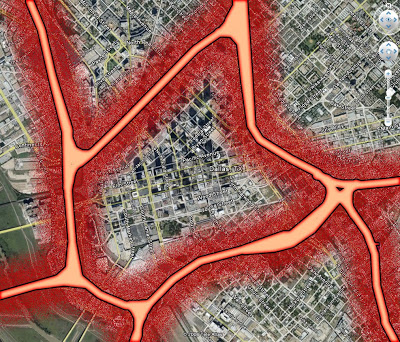So many conservative commentators hearken back to the Fifties as some glorious time in our history; you know, as Wade Davis says, “women were in the kitchen, black people were in the woodshed, and gays in the closet.” Now, here comes David Brooks calling for a very Eisenhower-y program:
How Keynesian, appropriate given the depression or potential depression for recovery, but it doesn’t have to be EXACTLY like Eisenhower’s plan of connecting cities:
Major highway projects take about 13 years from initiation to completion — too long to counteract any recession. But at least they create a legacy that can improve the economic environment for decades to come.
A major infrastructure initiative would create jobs for the less-educated workers who have been hit hardest by the transition to an information economy. It would allow the U.S. to return to the fundamentals. There is a real danger that the U.S. is going to leap from one over-consuming era to another, from one finance-led bubble to another. Focusing on infrastructure would at least get us thinking about the real economy, asking hard questions about what will increase real productivity, helping people who are expanding companies rather than hedge funds.
Ummm. The cities are already connected. Sure, some are in need of repair, but let’s focus on the bridges before the highways. Highway construction and maintenance is a boondoggle. The same style of handouts and trickle down policies that got us into this mess. They destroy real estate values and have an “unplugging” effect on the networks of commerce in our cities.
Moreover, an infrastructure resurgence is desperately needed. Americans now spend 3.5 billion hours a year stuck in traffic, a figure expected to double by 2020.
David, David, David. You are way out of your level of expertise. Aside from the tremendously corrosive effect highways have on cities, real estate, and, of course, quality of life, expansion never EVER reduce traffic. Why you say, because it adds capacity? Well, because highways force people onto the road and create demand to fill that increased capacity. And to do so, only forces people further and further away from each other, more disconnected, and stuck in traffic. This is simply an empirically failed supply-side solution when a demand-side one is called for, reduce people on the street by building walkable, bikable, transit-friendly communities.
As John Norquist oh so eloquently put it, “highways are like farts in an elevator. They are noisy, smelly, and nobody wants to be near them.”
This, in turn, means further flung land use patterns because development IS ALWAYS reactive to the transportation framework, which require more and more infrastructural investment to reach such low density development that cities end up underwater (financially speaking). I always find it ironic that the most conservative cities that I work with, which were so laissez-faire in terms of the planning and real estate development, ended up with the most sprawl. What did that get them? Conservative cities with some of the highest tax rates compared to their “competitor cities,” simply to afford all those linear feet of subterranean and surface infrastructure to support that development.
Here is the other rub, and I’ll have to track down the source because I read the study about five years ago. For every 17 cents of square foot it costs to maintain a highway, we fund only 14 cents which ensures a constant state of disrepair. We simply can’t afford them.
Brooks is right in that we need a massive New Deal or Eisenhower-style investment in putting people back to work and creating something with lasting value, but thinking stuck in fifties solutions is hardly what we need. We need to focus on cities, transportation, and interconnectivity of the 21st century that is focused on quality of life, clean energy, clean and efficient transportation and that is through investment in appropriately scaled rail service. High speed trains between major metropolitan areas, commuter trains linking major centers within megalopolitan areas, light rail connecting centers within MSAs, and modern streetcars running in the city.
Above is an older image that I’ve used a few times, but it illustrates the noose-like effect of the highways around downtown Dallas. The red “corrosion” effectively shows properties negatively affected by the highways. Accordingly, these are mostly vacant parcels and surface parking lots.







